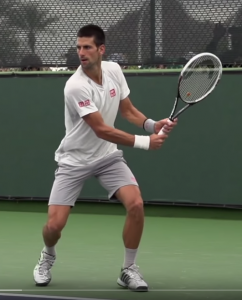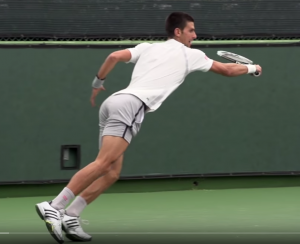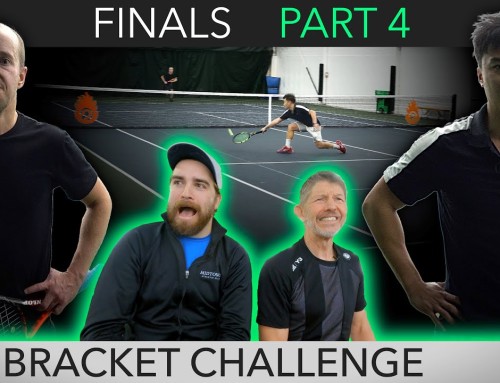How would you like to know a lob is coming from your opponents a full second BEFORE they hit it?
In this four part email series I’m going to tell you exactly what to look for to make that a reality.
There are signs and signals given every time a player lobs. Unfortunately they usually go completely unnoticed which is why so many people absolutely hate getting lobbed.
Let’s dive right into the second P of Lob Reading:
————–=====————–
Second “P”: Poise
As your opponent makes their way to the ball for their next shot they’re telegraphing what they’ll do next the whole way there…
A big part of that has to do with how much athletic balance they have in the last step or two before making their swing.
Aka “poise”. Let’s look a few real life examples, just like we did in Part 1:

The above image is a perfect example of athletic poise.
Novak has dynamically loaded his weight onto his left leg in preparation to transfer forward into the point of contact…
His posture is upright…
His torso is perfectly positioned in the middle of his stance (between his two feet) giving him tremendous control over what he can do next.
Long story short he can comfortably hit any shot he wants without any stress or strain.
Contrast that image with this one taken from the same practice session:

Now his feet are close together in a narrow base with one foot almost off the court…
His posture is thrusting out towards the ball at 45 degrees…
His torso is miles away from the center of his feet which means he has no choice but to fall in the direction he’s already set his movement.
Novak’s shot options from this position are dramatically restricted because he simply doesn’t have the balance or stability to hit anything offensive.
Poise is a HUGE indicator of what shot your opponent will hit next!
To be clear, Novak didn’t do anything “wrong” in the second image. Being off balance is a natural occurrence in tennis after one player or the other hits a great shot.
Unfortunately most amateur players love to admire their great shots and pat themselves on the back instead of studying their opponents to anticipate what shot is coming next.
If you paid close attention to Part 1 of this series then you probably quickly identified some other key factors in the second image above related to “preparation” of the racquet.
Poise and preparation are often linked but not always!
Honestly, the ones we’ve already talked about (preparation and poise) are enough to start reading 50% of the lobs coming your way…
…but miss the others and you’ll keep getting burned after approaching the net!
More on the way soon. Thanks so much for reading 🙂
Yours Truly,
-Ian



